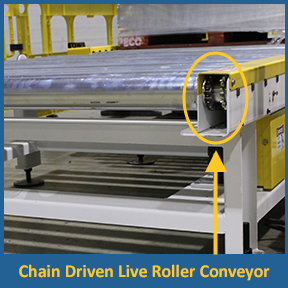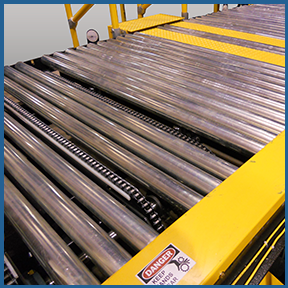Chain Driven Live Roller (CDLR) Conveyors in Industrial Manufacturing and Distribution Processes

Chain driven live roller with a motorized chain that powers the movement of the rollers transporting product.
Chain driven live roller (CDLR) conveyors represent a pivotal component in the landscape of material handling for industrial manufacturing and distribution. Characterized by their robust design and operational efficiency, CDLR conveyors utilize a series of rollers linked together with a lead roller attached to an adjacent chain set in motion by a motor. They are easy to maintain and undergo a lot of abuse without damage, making them ideal for moving heavy loads across the factory floor. The CDLR design is particularly effective for items with a smooth bottom, such as pallets, drums, or large pieces of machinery.
BASIC DESIGN AND WORKING PRINCIPLES
At its core, a CDLR conveyor consists of a series of rollers linked together by side chains. These chains are driven by a motor, which propels the rollers in unison, creating a uniform platform for material transport. The rollers are typically made from steel or aluminum, offering durability and the capacity to handle significant weight. The chain drive, situated either on one side or both sides of the conveyor, provides the necessary torque for movement, ensuring that even the heaviest items can be moved with relative ease.
TYPES OF PRODUCTS & OPTIMAL OPERATING CONDITIONS
Chain driven live roller conveyors are best suited for transporting heavy products with a smooth bottom surface. This includes everything from sheets and pallets to large castings and forgings. Their optimal operating conditions are within environments where durability and the ability to withstand harsh conditions are prerequisites. Due to its reliability and strength, industries such as automotive, metalworking, and packaging find immense value in CDLR technology.
PHYSICS & MECHANICS BEHIND CHAIN CONVEYORS
The efficacy of CDLR conveyors lies in the physics of distributed weight and mechanical power transmission. The chain drive transmits power from the motor to the rollers, ensuring consistent movement across the conveyor's length. This distribution of power means that large and heavy objects can be moved with minimal physical strain on any single part of the system.
Compared to other types of conveyors, such as belt-driven or gravity roller systems, CDLR conveyors offer superior load-bearing capacity and control. While belt-driven conveyors are efficient for lighter loads and gravity rollers rely on inclines for movement, CDLR conveyors provide direct power to move heavy items flatly or up slight inclines without manual intervention.
Request Quote ---- JOIN OUR MAILING LIST ---- Contact Us
Applications in Automated Robotic Systems

In modern manufacturing, CDLR conveyors integrate seamlessly with automated robotic systems for packaging, palletizing, securing, and depalletizing products. This synergy between conveyance and automation optimizes workflow efficiency and minimizes manual labor.
For instance, in a packaging line, CDLR conveyors can transport products to robotic arms programmed for precise placement and packaging. Similarly, in palletizing operations, robots can stack products on pallets moving along a CDLR conveyor, ensuring stability and accuracy in high-volume scenarios.
Pairing CDLR conveyors with other types of conveyors, such as belt conveyors for lighter items or vertical lift conveyors for changing elevations, creates a versatile material handling system capable of addressing a wide range of product types and weights.
Advantages and Examples
The primary advantages of CDLR conveyors include their durability, versatility, and compatibility with automated systems. For example, in the automotive industry, CDLR conveyors transport large car parts through assembly lines where robots perform tasks such as welding or assembly. Similarly, in distribution centers, these conveyors can move heavy pallets of goods through sorting and packaging processes, often interfacing with automated systems that scan and direct products to specific destinations.
In conclusion, Chain-Driven Live Roller conveyors are indispensable in industries requiring the robust, efficient transport of heavy items. Their design and mechanics ensure reliability and integration with automated systems, enhancing productivity and operational efficiency in diverse manufacturing environments.
Back to List of All Conveyor Types
Request Quote ---- JOIN OUR MAILING LIST ---- Contact Us
